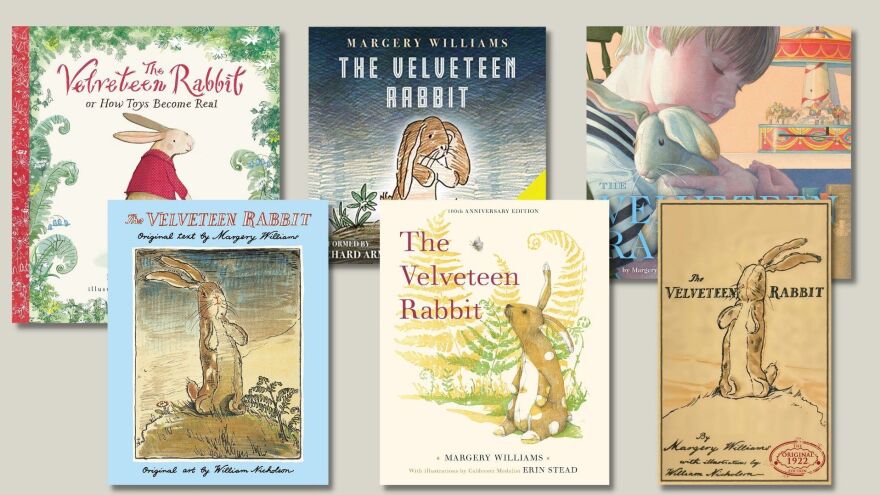Truth matters. Community matters. Your support makes both possible. LAist is one of the few places where news remains independent and free from political and corporate influence. Stand up for truth and for LAist. Make your year-end tax-deductible gift now.
As 'The Velveteen Rabbit' Turns 100, Its Message Continues To Resonate

What does it mean to be Real?
It's a big question for a children's book. The main character in The Velveteen Rabbit, first published in 1922, is a simple toy "stuffed with sawdust" and ears "lined with pink sateen."
He feels inadequate next to the fancier, mechanical toys who are "full of modern ideas, and pretended they were real."
So the Rabbit asks the Skin Horse, the oldest and wisest of the toys, "What is REAL?"
"Real isn't how you are made," said the Skin Horse.
"It's a thing that happens to you. When a child loves you for a long, long time,
Not just to play with, but REALLY loves you, then you become real."
"Does it hurt?" asked the Rabbit.
"Sometimes," said the Skin Horse, for he was always truthful.

In the age of 24/7 social media, hot takes and so-called Real Housewives, a story about authenticity might seem out of place. Yet Margery Williams Bianco's rabbit tale still resonates. Excerpts are read at weddings. There have been numerous print, screen and theater adaptations. The story has never gone out of print.
Caldecott Medalist Erin Stead, who illustrated a new, anniversary edition, believes The Velveteen Rabbit endures because it appeals to both children and grownups.
The notion of "what's real," says Stead, "carries with you for the rest of your life, with all of the relationships you have, all of the friendships that you'll make and all the times people aren't necessarily kind to you. There's a lot of insecurities. There's a lot of figuring out how you belong. It's hard to shake a story that's that honest."
Margery Williams was born in London in 1881. She was very close to her father who was a barrister and a classical scholar. Williams wrote that he "believed children should be taught to read early and then have no regular teaching until they were 10." Her favorite book was Wood's Natural History which she found in his library. "I knew every reptile, bird and beast in those volumes long before I knew my multiplication table," she recalled.
When Williams was 7 years old, her father died suddenly.
Throughout her life, Williams understood what it meant to be real, says her grandson, Mike Bianco. "She understood that all of these trappings of prestige and material possessions that we associate with being happy and what will endear us to others really fall short," he says, "because it's only when we allow ourselves to both give and receive unconditional love that we really become truly contented."
Psychotherapist Toni Raiten-D'Antonio was so inspired by the "hidden wisdom" in The Velveteen Rabbit that she wrote The Velveteen Principles: A Guide To Becoming Real and then followed it up with a similar book aimed at women. She believes Williams' story is just as relevant today as it was 100 years ago. "I get women in my practice daily who compare themselves to a Kardashian or to an influencer, and they hate themselves," she says. "They get surgeries to look like these people."
Raiten-D'Antonio praises the story for both defining what being "real" feels like but also for telling readers the journey there "takes a long time."
"What I was seeing in my practice was that these people had become squashed by their unreality, their lack of self-acceptance and lack of self-awareness." In today's culture, "The whole idea of being a real person, an authentic person, takes a lot of guts," she says.
Margery Williams once wrote that her most famous story came about as she was reminiscing about her childhood.

"By thinking about toys and remembering toys, they suddenly became very much alive — Poor Cecco and all the family toys that had been so much a part of our lives; toys I had loved as a little girl — my almost forgotten Tubby who was the rabbit, and old Dobbin the Skin Horse (who belonged to my brother, and) the toys my children had loved," she wrote.
In the story, the Rabbit is elated when he finally hears the Boy refer to him as "real." Writer Laurel Davis Huber, author of the novel The Velveteen Daughter, says Margery Williams' story has particular meaning, "to people who maybe have an illness or just in general feel like an outsider for any reason whatsoever."
Kristy Barrett says she's "always felt a little bit like a human Velveteen Rabbit."
Barrett was born prematurely. "They told my mom when I was being born not to get attached because I wasn't going to live," she says. Barrett has cerebral palsy. As she got older, she faced numerous health issues including rheumatic fever. Now 50, Barrett says The Velveteen Rabbit is her favorite book.
She says the part that "grabbed me by the heart" is when the Skin Horse tells the Rabbit:
"...by the time you are real, most of your hair has been loved off, and your eyes drop out and you get loose in the joints and very shabby. But these things don't matter at all, because once you are real you can't be ugly, except to people who don't understand."
"If you look at me, my body's very twisted," Barrett says, "so I kind of fit the 'your joints get loose and you become very shabby.' But most of the people who know me and love me, look at me and see the beauty even though my body's always been twisted and different."
In 1904, Margery Williams married Francesco Bianco, an Italian book dealer living in London. They had a daughter, Pamela Bianco, who was a child prodigy. Pamela's story inspired Laurel Davis Huber to write The Velveteen Daughter. As a little girl, Pamela's art was shown in major galleries in Europe and the U.S. and written about in major publications. The early fame took a toll on Pamela. She was hospitalized for depression.
Huber says some people find The Velveteen Rabbit, "a little sentimental." She disagrees. "What is sentiment? Sentiment is feeling. If we don't feel, then we aren't really human," Huber says.
"It is true that some of the most beautiful stories ever written for children ... have been sad stories," Williams Bianco wrote in the literary magazine The Bookman in 1925. "But it is the sadness which is inseparable from life, which has to do with growth and change and impermanence, and with the very essence of beauty."
She also wrote, "To engage children's interest in anything you have to be keenly interested in that thing yourself."
Copyright 2024 NPR. To see more, visit npr.org.







